Did you know that red leaf lettuce is not only a vibrant addition to your plate, but also a nutritional powerhouse? This leafy green vegetable packs a punch when it comes to essential vitamins and minerals, making it a must-have for a healthy diet. Whether you’re a salad lover or looking to boost your overall well-being, organic red leaf lettuce is a fantastic choice.
Key Takeaways:
- Red leaf lettuce is a nutrient-dense leafy vegetable with a vibrant red or purple-tinged tips.
- It is low in calories but rich in essential vitamins and minerals, including vitamin A, vitamin K, and magnesium.
- Red leaf lettuce is high in antioxidants like beta carotene and anthocyanins, which protect against free radicals and inflammation.
- Incorporating red leaf lettuce into your diet can support heart health, aid in weight loss, promote hydration, and contribute to healthy vision.
- You can easily include red leaf lettuce in your meals through salads, sandwiches, and other flavorful recipes.
Nutritional Value of Red Leaf Lettuce
Red leaf lettuce is a powerhouse of nutrients, offering a range of health benefits while being low in calories. A 3-cup serving (85 grams) of shredded red leaf lettuce contains a rich mix of essential vitamins and minerals, making it a nutritious addition to any diet.
Here is a breakdown of the nutritional value of red leaf lettuce:
| Nutrient | Amount per Serving |
|---|---|
| Vitamin A | 78% of the daily recommended intake |
| Vitamin K | 122% of the daily recommended intake |
| Magnesium | 5% of the daily recommended intake |
| Folate | 8% of the daily recommended intake |
| Iron | 4% of the daily recommended intake |
Red leaf lettuce is comparable in nutritional value to other leafy vegetables like green leaf, romaine, and iceberg lettuce, making it a versatile choice for salads, sandwiches, and other dishes.
To maintain the freshness and nutritional value of red leaf lettuce, it’s important to store it properly. Here are the best ways to store red leaf lettuce:
- After purchasing or harvesting, remove any damaged or wilted leaves.
- Wash the lettuce thoroughly and dry it gently using a salad spinner or paper towels.
- Place the lettuce in a plastic bag or airtight container to prevent moisture loss.
- Store the lettuce in the refrigerator, ideally at a temperature of around 32°F to 36°F.
- Consume the lettuce within a few days for maximum freshness.
Health Benefits of Red Leaf Lettuce
Red leaf lettuce is not only delicious but also offers a wide range of health benefits. Its nutrient-density makes it an excellent addition to any diet. Let’s explore some of the key benefits of incorporating red leaf lettuce into your meals.
Supports Heart Health
By including red leaf lettuce in your diet, you can promote a healthy heart. Red leaf lettuce is rich in potassium and magnesium, which are essential minerals for maintaining a healthy heartbeat and supporting cardiovascular function. These minerals have been linked to a lower risk of heart-related disorders such as high blood pressure and heart failure.
Promotes Hydration
Red leaf lettuce is hydrating due to its high water content. Staying properly hydrated is vital for various bodily functions, including temperature regulation, joint lubrication, nutrient delivery, digestion, and overall organ function. Incorporating red leaf lettuce into your meals can help you stay hydrated and support overall health.
Aids in Weight Loss
If you’re looking to shed some extra pounds, red leaf lettuce can be your ally. This leafy green is low in calories and high in fiber, which promotes a feeling of fullness and reduces calorie intake. Including red leaf lettuce in your meals can contribute to your weight loss efforts.
Protects Against Oxidative Stress and Inflammation
The antioxidants found in red leaf lettuce, such as beta carotene and anthocyanins, help protect the body against oxidative stress and inflammation. Oxidative stress and chronic inflammation are linked to various diseases, including heart disease and certain types of cancer. Adding red leaf lettuce to your diet can provide a good source of these beneficial antioxidants, contributing to your overall well-being.
Supports Healthy Vision
Vitamin A, which is abundant in red leaf lettuce, plays a crucial role in maintaining healthy vision. It aids in converting light into electrical signals in the eyes, and it has been associated with a reduced risk of cataracts and macular degeneration. Including red leaf lettuce in your diet can support optimal eye health and promote clear vision.
As you can see, red leaf lettuce offers an array of health benefits, ranging from heart health and hydration to weight loss and vision support. Incorporating this nutrient-packed lettuce into your meals is a simple and delicious way to boost your overall health and well-being.
| Benefit | Description |
|---|---|
| Heart Health | Red leaf lettuce supports a healthy heart by providing essential minerals, such as potassium and magnesium. |
| Hydration | With its high water content, red leaf lettuce helps maintain adequate hydration levels and supports overall health. |
| Weight Loss | Low in calories and high in fiber, red leaf lettuce can contribute to weight loss efforts. |
| Antioxidant Power | Red leaf lettuce contains antioxidants that protect against oxidative stress and inflammation, supporting overall well-being. |
| Vision Support | Vitamin A in red leaf lettuce promotes healthy vision and reduces the risk of certain eye conditions. |
Red Leaf Lettuce for Heart Health
While no direct studies have been conducted on the effects of red leaf lettuce on heart health, it is known that a diet rich in fruits and vegetables, including lettuce, can reduce the risk of heart disease.
Red leaf lettuce contains significant amounts of potassium and magnesium, which are essential for maintaining a healthy heartbeat and supporting cardiovascular function. These minerals have been linked to the prevention of high blood pressure, heart failure, and other heart-related disorders.
Including red leaf lettuce in a balanced diet can contribute to a healthy heart.
| Nutrient | Amount per 100g |
|---|---|
| Potassium | 247mg |
| Magnesium | 13mg |
Source: USDA National Nutrient Database for Standard Reference
By consuming red leaf lettuce regularly, you can support your heart health and enjoy the many benefits of this nutritious leafy vegetable.
Red Leaf Lettuce for Vision Health
When it comes to maintaining healthy vision, red leaf lettuce is a natural choice. This vibrant leafy green is rich in vitamin A, which plays a crucial role in supporting eye health. Vitamin A is responsible for converting light into electrical signals in the eyes, aiding in clear vision and visual acuity.
Regular consumption of red leaf lettuce can help reduce the risk of age-related eye conditions, such as cataracts and macular degeneration. These conditions often develop as a result of oxidative stress and inflammation in the eyes. However, the powerful antioxidants found in red leaf lettuce, including beta carotene and anthocyanins, help protect against these harmful processes.
To further illustrate the vision benefits of red leaf lettuce, here is a simple table:
| Benefits | Effect on Vision Health |
|---|---|
| Rich in vitamin A | Supports eye health and function |
| Contains antioxidants | Protects against oxidative stress and inflammation |
| Reduces risk of cataracts | Helps maintain clarity of the lens |
| Reduces risk of macular degeneration | Preserves central vision and visual sharpness |
As you can see, red leaf lettuce provides a holistic approach to vision health by nourishing the eyes with essential nutrients and offering protection against age-related eye conditions. Including red leaf lettuce in your diet can contribute to maintaining optimal vision and supporting long-term eye health.
Remember, a healthy diet rich in a variety of fruits and vegetables is important for overall well-being, including vision health. So why not add some delicious red leaf lettuce to your meals and enjoy the benefits it has to offer?
Red Leaf Lettuce for Hydration
When it comes to staying hydrated, red leaf lettuce can be a refreshing addition to your diet. With its high water content, this leafy vegetable helps replenish fluids in the body and supports optimal hydration levels.
Hydration is crucial for various bodily functions, including temperature regulation, joint lubrication, nutrient delivery, digestion, and overall organ function. By maintaining adequate hydration, you can support your body’s natural processes and promote overall health and well-being.
Did you know? Red leaf lettuce is composed of about 95% water, making it a hydrating powerhouse.
“Proper hydration is essential for various bodily functions, including temperature regulation, joint lubrication, nutrient delivery, digestion, and overall organ function.”
By incorporating red leaf lettuce into your meals, you can take a delicious step toward hydration. Whether you enjoy it as part of a salad, sandwich, or wrap, this leafy green can contribute to your daily water intake and help you maintain optimal hydration throughout the day.
Stay tuned: In the next section, we explore how red leaf lettuce can contribute to weight loss and support healthy eating habits.
Red Leaf Lettuce for Weight Loss
When it comes to weight loss, incorporating red leaf lettuce into your diet can be a game-changer. This nutrient-packed vegetable is not only low in calories but also high in fiber and water content, making it an excellent choice for those looking to shed a few pounds.
The high fiber content of red leaf lettuce helps promote feelings of fullness, which can reduce calorie intake and prevent overeating. Additionally, the water content in red leaf lettuce adds volume to your meals without adding extra calories, allowing you to enjoy a satisfying meal while keeping your calorie count in check.
Did You Know? Red leaf lettuce is a great source of dietary fiber, providing approximately 1.3 grams of fiber per 100 grams (Source: USDA National Nutrient Database).
Incorporating red leaf lettuce into a balanced diet is a simple and effective way to support your weight loss efforts. Whether you choose to add it to your salads, sandwiches, or wraps, red leaf lettuce provides a refreshing crunch and a burst of flavor to your meals while helping you achieve your weight loss goals.
| Nutrient | Amount per 100 grams |
|---|---|
| Calories | 16 |
| Fiber | 1.3 grams |
| Water | 94.9 grams |
| Vitamin C | 9% |
| Vitamin K | 205% |
| Vitamin A | 139% |
Table: Nutritional information of red leaf lettuce per 100 grams.
Including red leaf lettuce in your weight loss journey not only provides you with essential nutrients but also helps you create a delicious and satisfying meal plan. So go ahead and enjoy the crunch, flavor, and weight loss benefits that red leaf lettuce has to offer!
Red Leaf Lettuce and Antioxidants
Red leaf lettuce is not only delicious but also packed with powerful antioxidants that can benefit your health. By incorporating this vibrant leafy vegetable into your diet, you can enjoy the protective effects of antioxidants, such as beta carotene and anthocyanins. These compounds work to combat oxidative stress and reduce inflammation in the body, which are factors associated with various diseases.
Antioxidants play a crucial role in safeguarding your overall well-being. They help neutralize harmful free radicals that can damage cells and contribute to the development of chronic conditions. Studies have shown that a diet rich in antioxidants can lower the risk of heart disease and certain types of cancer.
To provide a visual representation of the antioxidant content in red leaf lettuce, refer to the following table:
| Antioxidants in Red Leaf Lettuce | Amount |
|---|---|
| Beta Carotene | XX micrograms |
| Anthocyanins | XX milligrams |
By consuming red leaf lettuce regularly, you can introduce a rich source of these beneficial antioxidants into your diet and support your body’s defense against oxidative damage. Whether enjoyed in a salad, sandwich, or another culinary creation, red leaf lettuce provides a flavorful and nutritious way to incorporate antioxidants into your daily meals.
Stay tuned for the next section, where we will explore some delicious recipes and innovative ways to incorporate red leaf lettuce into your culinary repertoire.
How to Incorporate Red Leaf Lettuce into Your Diet
Red leaf lettuce is a versatile and nutritious ingredient that can be easily incorporated into your daily meals. Whether you’re looking to make a refreshing salad or trying out new recipes, cooking with red leaf lettuce adds a burst of color, flavor, and health benefits to your dishes.
Salads: Use red leaf lettuce as a base for your salads to add vibrant color and a mild, slightly sweet flavor. Combine it with other fresh vegetables, fruits, proteins, and dressings to create a refreshing and nutritious salad. Here’s a simple recipe to get you started:
Red Leaf Lettuce Salad with Grapefruit and Avocado
- Ingredients:
- 1 head of red leaf lettuce, washed and torn into bite-sized pieces
- 1 grapefruit, peeled and segmented
- 1 avocado, sliced
- 1/4 cup of toasted walnuts
- 2 tablespoons of extra virgin olive oil
- 1 tablespoon of balsamic vinegar
- Salt and pepper to taste
- Instructions:
- In a large bowl, combine the red leaf lettuce, grapefruit segments, avocado slices, and toasted walnuts.
- In a small bowl, whisk together the extra virgin olive oil, balsamic vinegar, salt, and pepper.
- Pour the dressing over the salad and toss gently to combine.
- Serve immediately and enjoy!
Sandwiches and Wraps: Add a layer of red leaf lettuce to your sandwiches or wraps for an extra crunch and fresh taste. It pairs well with various fillings such as grilled chicken, turkey, roasted vegetables, or even hummus and falafel. The possibilities are endless!
Recipes: Red leaf lettuce can also be used in cooked dishes like lettuce wraps or stir-fries. Its sturdy leaves hold up well to heat and add a crisp texture to your meals. Here’s a simple lettuce wrap recipe:
Asian Lettuce Wraps
- Ingredients:
- 1 pound ground chicken or turkey
- 1 tablespoon vegetable oil
- 2 cloves of garlic, minced
- 1 tablespoon of ginger, grated
- 2 tablespoons of soy sauce
- 1 tablespoon of hoisin sauce
- 1 tablespoon of rice vinegar
- 1 cup of shiitake mushrooms, sliced
- 1/2 cup of water chestnuts, chopped
- 1/4 cup of green onions, chopped
- 1 head of red leaf lettuce, leaves separated
- Instructions:
- In a large skillet, heat the vegetable oil over medium heat. Add the ground chicken or turkey, garlic, and ginger. Cook until the meat is browned and cooked through.
- In a small bowl, whisk together the soy sauce, hoisin sauce, and rice vinegar. Pour the sauce over the cooked meat and stir to coat.
- Add the shiitake mushrooms, water chestnuts, and green onions to the skillet. Cook for an additional 2-3 minutes until the vegetables are tender.
- To serve, spoon the meat mixture into the red leaf lettuce leaves, creating lettuce wraps.
- Enjoy the delicious and healthy Asian lettuce wraps!
These are just a few examples of how you can cook with red leaf lettuce. Get creative and experiment with different flavors and ingredients to discover your own favorite recipes!
Remember, cooking with red leaf lettuce not only adds a delightful taste to your dishes but also provides you with essential vitamins, minerals, and antioxidants. So, next time you’re planning a meal, consider adding this nutritious leafy green to your shopping list and enjoy the benefits it brings to your health!
Best Ways to Store Red Leaf Lettuce
To maintain the freshness and quality of red leaf lettuce, it is important to store it properly. After purchasing or harvesting, follow these best practices:
- Store in a plastic bag or airtight container: Place the red leaf lettuce in a plastic bag or an airtight container to protect it from moisture and exposure to air.
- Refrigerate: Store the lettuce in the refrigerator at a temperature between 35°F and 40°F (1.7°C and 4.4°C) to help prolong its freshness.
- Wash just before using: It is best to wash the red leaf lettuce just before using it to avoid excess moisture, which can lead to wilting.
- Remove excess moisture: Gently pat the lettuce leaves dry with a clean kitchen towel or use a salad spinner to remove excess moisture before storing.
- Separate leaves: If the red leaf lettuce is sold in a head, separate the leaves before storing to allow for better airflow and reduce the chances of spoilage.
It is worth noting that organic red leaf lettuce may have a shorter shelf life compared to conventionally grown lettuce. Therefore, it is essential to consume organic red leaf lettuce within a few days of purchase to enjoy its optimal freshness and nutritional benefits.
Tips for Extending the Shelf Life of Red Leaf Lettuce:
- Don’t wash the lettuce immediately after purchase: Washing the lettuce too early can introduce excess moisture and speed up spoilage. Wait to wash until right before using it.
- Trim the stems: Before storing, trim the stems of the lettuce leaves to remove any wilted or damaged portions.
- Avoid exposure to ethylene: Keep red leaf lettuce away from ethylene-producing fruits and vegetables, such as apples and bananas, as these can accelerate spoilage.
- Check for any signs of spoilage: Regularly inspect the lettuce for any signs of decay or mold. Discard any leaves that appear slimy, discolored, or have an off odor.
By following these best practices and tips, you can ensure that your red leaf lettuce stays fresh, crisp, and ready to enjoy for as long as possible.
Conclusion
Red leaf lettuce is a nutritious and versatile leafy vegetable that provides a wide range of health benefits. With its rich array of essential vitamins and minerals, low-calorie content, and high antioxidant properties, incorporating red leaf lettuce into your diet can have a positive impact on your overall well-being.
This vibrant lettuce variety supports heart health by offering significant amounts of potassium and magnesium, which are essential for maintaining a healthy heartbeat and supporting cardiovascular function. Additionally, red leaf lettuce is a hydrating food, thanks to its high water content, contributing to optimal hydration levels and supporting various bodily functions.
For individuals looking to achieve or maintain a healthy weight, red leaf lettuce is an excellent choice. It is low in calories and high in fiber, promoting feelings of fullness and reducing calorie intake. As part of a balanced diet, red leaf lettuce can be a valuable component in weight loss efforts.
Furthermore, red leaf lettuce is a powerhouse of antioxidants, such as beta carotene and anthocyanins, which protect against oxidative stress and inflammation. These antioxidants have been linked to a reduced risk of heart disease, certain types of cancer, and other chronic illnesses.
Whether enjoyed in salads, sandwiches, or cooked in various recipes, red leaf lettuce is an easy and delicious way to boost your nutrient intake and support your overall health. By incorporating this nutrient-dense leafy vegetable into your daily meals, you can reap the benefits of red leaf lettuce and take significant strides towards a healthier lifestyle.

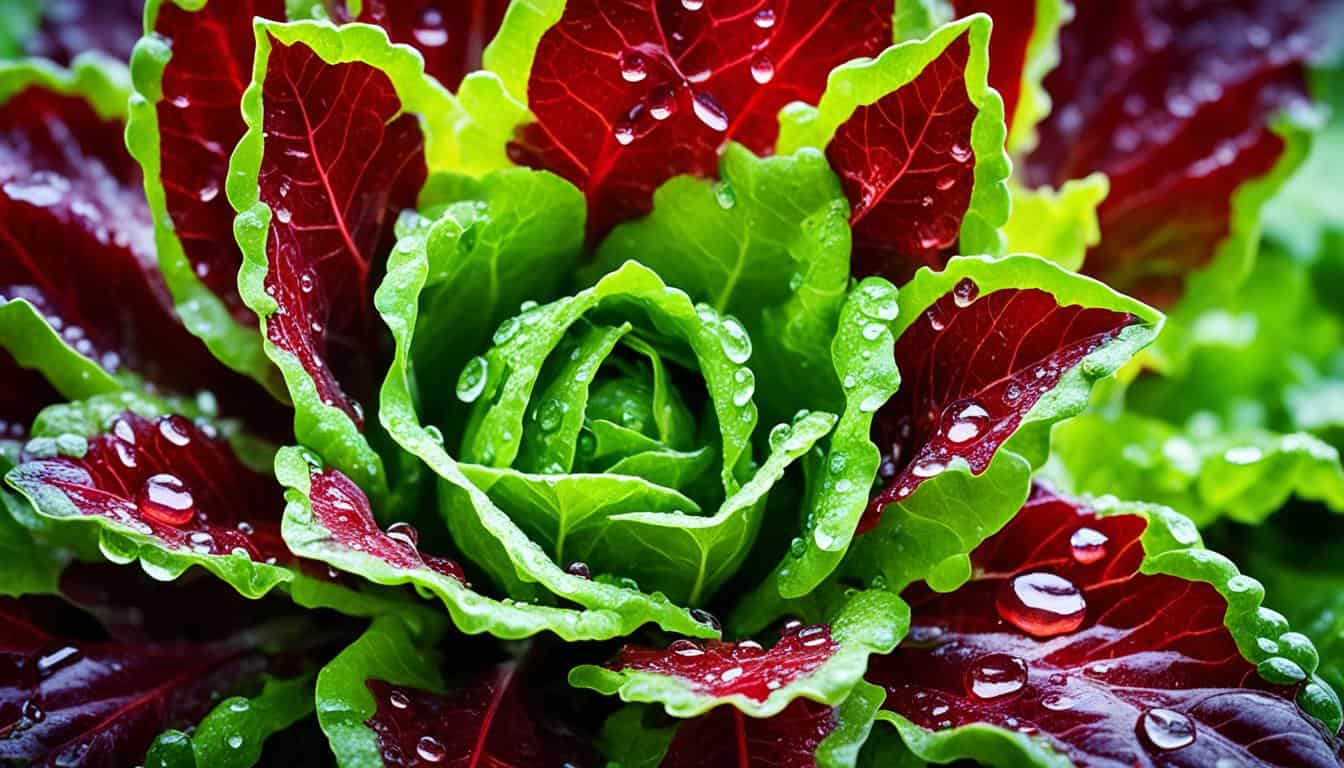
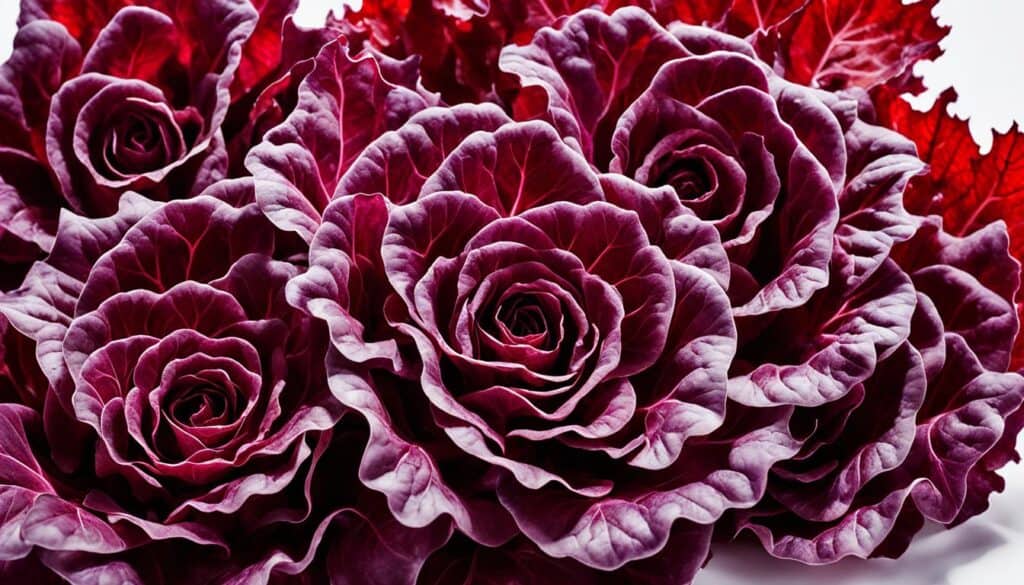
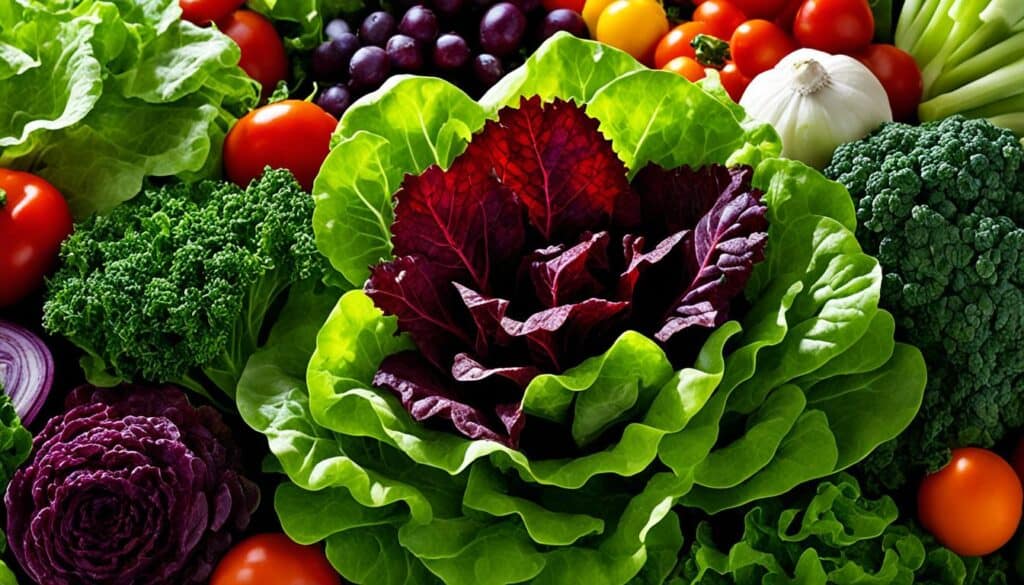

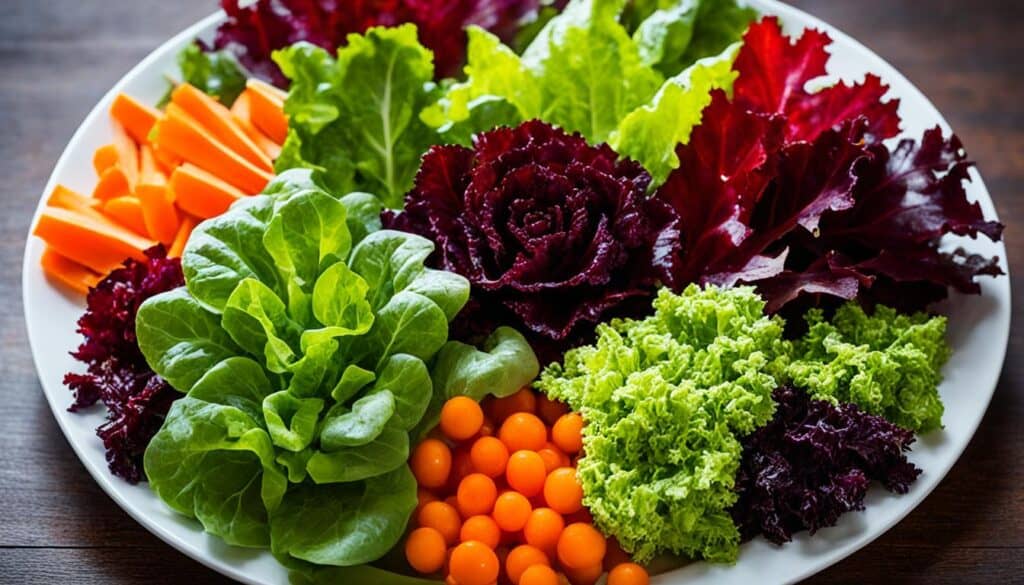
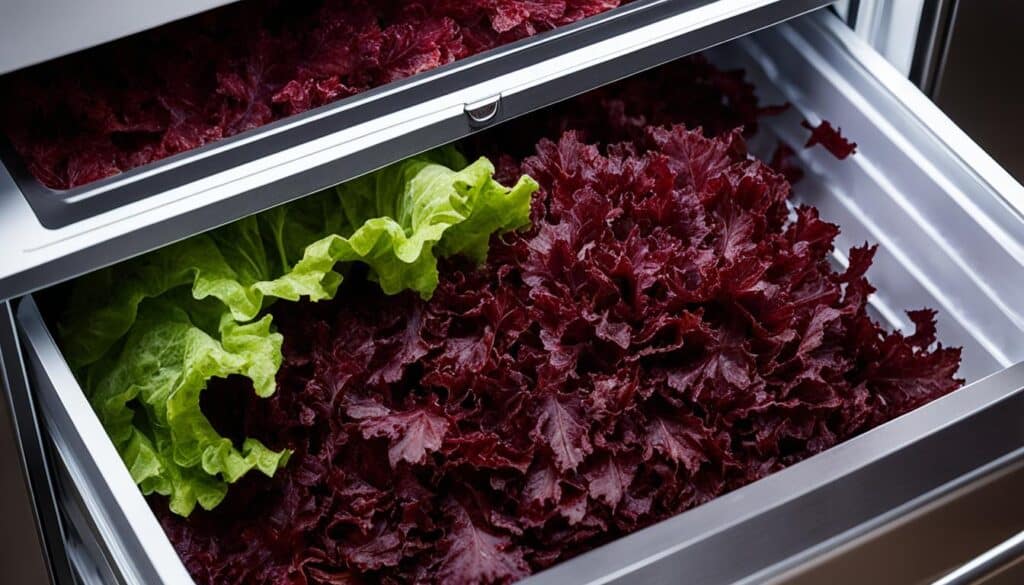



Leave a Reply